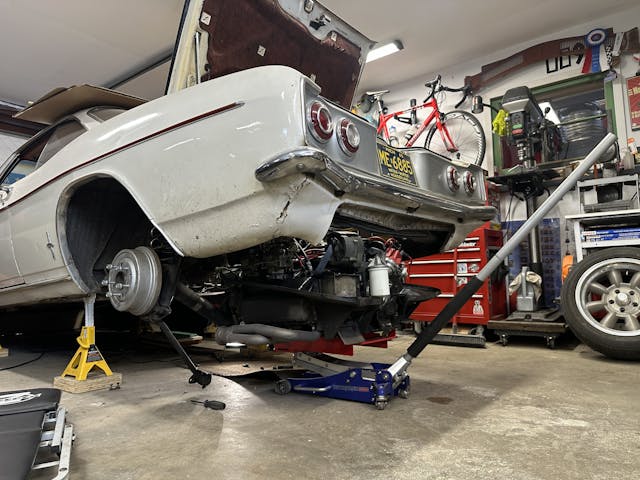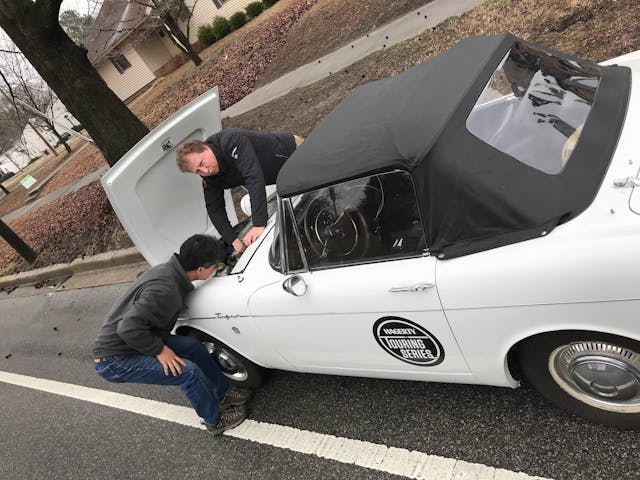Media | Articles
6 DIY Lessons We All Learn Eventually
Like many other tasks and toils that modern humans endure and embrace over their lifetimes, maintaining a vintage car comes with a learning curve. We all start at the bottom, looking up at a mountain of knowledge and understanding that can somehow often be intimidating, exciting, frustrating, and humbling all at once.
It’s a climb that many of us have made some amount of progress on. Often along the way, we’re either trying to learn from those ahead of us or trying to help those a few steps behind. While the project car learning curve is unique to every person, there are a few universal truths that anyone who has attempted a project car will experience. Here are six I’ve become intimately familiar with. Be sure to add yours in the comments below.
An hour of diagnostics is worth two hours of parts replacing

Fixing something that is not broken or malfunctioning is just a waste of time at the end of the day. This means that the best course of action at the onset of a project is to do diagnostics and confirm that the problem you are working on actually needs solving.
Diagnostics aren’t the fun part of a project, but understanding how a system of parts works when attempting to restore function makes for a much less frustrating time under the hood. Haphazardly throwing parts at a project can tax your pockets and your spirit to an unnecessary degree.
Project car budgets are little lies we tell ourselves

The initial purchase price of a project car is often the main number that comes to mind when thinking about the partially finished hulk sitting in the driveway. While that is part of the expense and cost of playing with cars, many other things total up and conspire to pull pennies, dimes, and dollars from your bank account.
Marketplace
Buy and sell classics with confidence
A trip to the parts store for a $10 part can easily turn into a $50 trip when you grab that can of brake cleaner, some random hardware, and a couple of quarts of oil to keep up with that leak you haven’t gotten to yet. Was that still a $10 parts run? How much accounting do you really keep? I know I’m bad about keeping accurate totals, and I’m certainly not in the minority.
It’s okay to call the professionals

Project cars can be extremely rewarding, but often the reward requires going through the frustration of actually doing the work. Sometimes things spiral to a daunting point where we may or may not have the skills, time, or tools to handle. While some thrive on clawing their way out after getting in over their head, that is not for everyone or every situation–and that’s okay. There is no shame in calling in a favor from someone more experienced than you or simply booking an appointment with a professional. Knowing your limits is the key to having fun while working on cars.
Expect the unexpected

Even on projects you have experience with, the aging components of most vintage vehicles mean that whatever you think the problem is might be nothing more than a red herring to the real issue. Add in that our old cars have endured decades of driving but also decades of being maintained, or sometimes more accurately, “maintained.” When your diagnostics point to something that could be caused by two problems, don’t rule out either until you’ve put your eyes and hands on all of the potential offending parts.
“Making it work” is not always worth it

When you do run into the unexpected, there is always the temptation to take what you have on hand and create a solution right then and there. Sometimes that is the best course of action but more often than not everyone benefits from taking a moment to sit with the issue and make sure that you are not putting a band-aid on a much needier wound. Taking the time to craft the proper solution might not always be an option, but you should consider that in earnest when the opportunity allows.
Your memory is so much worse than you think

How many of us have disassembled something—a carburetor for instance—and told ourselves “I’ll remember where that check ball goes” only to get sidetracked by something else for an hour? When you return to the workbench, that scattered mess of parts suddenly feels like the world’s dirtiest puzzle that you swear now has an extra check ball.
Documenting each step in a process or having the proper reference materials on hand to ensure this doesn’t happen is often no more difficult than buying a shop manual or snapping a handful of pictures with a digital camera or cellphone. Writing down reference notes is not cool, but you know what else isn’t cool? A mysterious extra check ball. If you want to minimize the time that your project is in pieces rather than on the road, swallow your pride and take good notes.


















Actually a question for Mr. Smith:
I noticed a steel plate between the floor jack and the motor of your Corvair. I would like to know please if that is a fabrication you made or something you were able to purchase and where if so. I have a ’66 that has been in the family since new and it is time to take it all apart for restoration. Please don’t tell me how much that will cost!!
Thank you.
That engine “cradle” is something I purchased years ago from Dave Watson who designed and had them fabricated. I forget what I paid, honestly and I’m not sure if he is still making runs of them anymore. Asking around on the Corvair forums and Facebook groups might rustle one up though. It’s a very similar design to the wooden one outlined in “How to Keep Your Corvair Alive” and having used both, I could go either way. This metal one is just a lot sturdier and more durable.
Thank you!
Concerning the memory, turned wrench’s professionally for 45 yrs, just found out that that little camera on my phone can save me a whole lot of frustration when it comes to going back together with just about anything or remembering the wire routing. Memory ain’t as good as it use to be. Take a few pics of what your tearing apart before you tear it apart and it sets for a few weeks before going back together.🥴
“…get sidetracked by something else for an hour…”
The sad truth is it never just an hour. You blink and 6 months go by, then 6 years!
some of the diy lessons i’ve learned about cars as one of my hobbies: it ain’t rational, it’s a money pit, and it can keep your daily driver out of the garage (do i need to explain the last one?). and like any addiction, it can take over your life if you’re not careful. looking back at my “horrible addiction”, i would’ve done a number of things differently. but at the same time, i’m ok where i’m at today. what good is making a mistake if you don’t learn from it? and without this article, how would i pick up on a lot of good tips, be amused at humorous comments, and be “grateful i didn’t do that”???
I knew all of ’em, I just have to re-learn them…. often.
I really don’t understand Why one would keep track of what they spend on a Hobby or enjoyment–Unless it’s Not a hobby & more of an investment for you–If your in it for money it is no longer a hobby– If you were collecting Stamps/coins/ playing chess would you document every dollar you spent?
Lessons learned:
1. Not all professionals are as knowledgeable as they want you to believe. To borrow from Aaron Robinson, no one cares as much about your car as you.
2. During the honeymoon phase of initial ownership you are certain you will make countless road trips and be the center of attention whenever and wherever you park the car. The chances of this happening diminishes with each day, week, or year the car is in your shop.
3. When, or if you sell the car someone will be happy the car is gone and you have a stack of money. It will not be you.
4. When driving, an old car will do things with you but not for you. This was a wonderful and fun lesson to learn!
Counterpoint: Do not keep records. I don’t want to know and I certainly don’t want my wife to even have a clue.
My greatest fear, is that when I die my wife will sell my car for what I told her I had in it.
also “the most expensive car in the world is a cheap Jaguar”
Another lesson I just relearned- the more mysterious and subtle a car problem is, the more likely a simple, low-cost fix is the answer (don’t ask about the $200 I just spent on electrical system parts when it was a bad ground issue)
Parts left over? Heck, anyone can make it work with *all* the parts. It takes true brilliance to make it work with fewer.
“Your memory is much worse than you think” learning is not restricted to just the older among us.
As a kid, I decided to use the family’s newish Lawn Boy push mower – which was completely operational at the time – as my term project for my junior high school industrial arts class. Came apart very easily. Who needs to document anything? Repair manual? Bah. Why? Four months later – with a handful of parts I couldn’t find a home for anywhere on the machine – I finally got it back together. Those parts were clearly redundant.
After about 200 tugs on the starter rope, it roared back to life. I was elated for about 30 seconds until the connecting rod launched itself thru the crankcase. It died a horrible death.
My Dad was not amused. I spent the rest of summer mowing neighbor’s lawns to pay him back for the new Lawn Boy mower the family needed to purchase.
When approaching my first motor build someone told me bag, tag and photograph everything as if your wife and kids were going to have to put it all back together without you around. It was great advice. It gave me the patience and humor to take careful notes, label every single zip lock bag and have a file of pics and videos to work from when if I needed them. It’s amazing how much I forgot even after a few short months.
Also, I try to accept that it’ll take three trys to get a complicated process completed. So if it only takes two passes I feel ahead of the game but if I have to do it a third time I hope to have a bit more fuse left till I blow.
I had a set of color coded clips- one for each end of the disconnected parts. Gave them away and now regret it. I think I gave it to a friend that said he had a “photogenic “ memory. I think it was from a tool truck many years ago.
In addition to photographs and notes, get a supply of Ziploc bags for small parts and label the bags. You frequently encounter small parts made specifically for one application; lose it and you’re in trouble!
Before I take anything apart I make sure the solution to the repair is on YouTube. I have yet to not find ANY repair there!